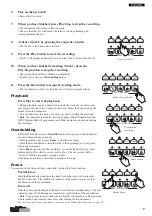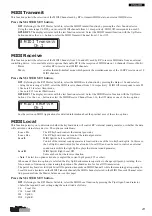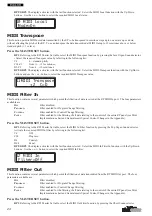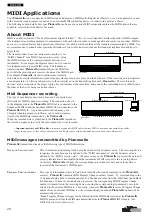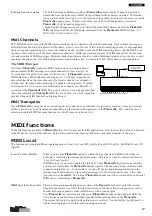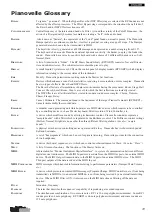
26
MIDI Applications
Your
Pianovelle
can be connected in MIDI setups and used as a MIDI controlling device (Master), or as a tone generator (a unit
with an internal sound engine) connected to an external MIDI controlling device (in other words, used as a Slave).
The following section details how your
Pianovelle
can be used in various MIDI setups and explains the MIDI options that are
available, selected from the Master Set menu.
About MIDI
MIDI is an abbreviation for “Musical Instrument Digital Interface”. This is a world standard interface that allows MIDI compat-
ible instruments and other equipment to communicate with each other in order to exchange data and control one another. MIDI is
now a very common feature and a great deal of literature is available which explains all the standards implemented by MIDI. You
are recommended to consult other specialised literature if you wish to know more about the standards implemented and how to
apply them.
The transfer of data from one instrument to another is via
“MIDI Channels” (see MIDI Channels afterwards), using
the MIDI interface as the common element between two
instruments. For example, the diagram shows how to connect
two instruments in a typical MIDI setup. The instrument
transferring data (
Pianovelle
) transmits from the MIDI Out
port while the receiving unit receives the data at the MIDI In port.
For example, Pianovelle, like most instruments, transmits
note data and velocity information (touch response) whenever notes are played on the keyboard. If the receiving unit incorporates
a sound generator, it will respond precisely to the notes played on the transmitting keyboard (Pianovelle). The result is quite
obvious: such a setup allows the player to play two instruments at the same time, using one as the controlling device (Master) and
the other as the device being controlled (Slave).
Midi Sequencer recording
The type of data transfer described above can be exploited very
efficiently for MIDI sequence recording. The connection, shown
in the diagram, where the
Pianovelle
MIDI Out is connected to the
Sequencer MIDI In and the Sequencer MIDI Out is connected to the
Pianovelle
MIDI In. Any instrument with a sequencer, or a
Computer running sequencer software, can be used to capture
(record) the MIDI data transmitted by the
Pianovelle
.
When the recorded data is played back, the
Pianovelle
reproduces
the recorded sequence in exactly the same manner as it was recorded.
• Important user info on MIDI cables: always use high quality MIDI cables for your MIDI connections and avoid using cables
longer than approx. 15 feet: cables which exceed this length tend to pick up unwanted noises and can cause data errors.
MIDI messages transmitted by Pianovelle
Pianovelle
transmits and receives the following type of MIDI information.
N
OTE
AND
V
ELOCITY
DATA
This is information pertaining to the note played and relative dynamic value. The receiving device
recognises the note because it is defined by the “MIDI note number”, and the dynamic value is
defined by the “MIDI velocity value”. Whenever a key on the
Pianovelle
is pressed, the note and
velocity information is transmitted from the instrument’s MIDI Out port to the receiving device.
Conversely,
Pianovelle
will play the corresponding notes whenever note and velocity data is
received at the instrument’s MIDI In port.
P
ROGRAM
C
HANGE
NUMBERS
This type of information relates to data which identifies the sounds contained in the
Pianovelle
memory.
Pianovelle
transmits MIDI Program Change numbers from 0 - 31, corresponding to the
16 Sounds shown on the command panel and 16 Sounds available from the Additional Sound Bank
(ASB button). Whenever a Sound button is pressed, the corresponding MIDI Program Change
number is transmitted to the receiving device, causing the correspondingly numbered voice to be
selected in the external MIDI unit. Conversely, whenever
Pianovelle
receives a Program Change
number from an external MIDI device, the correspondingly numbered
Pianovelle
Sound will be
automatically selected.
• Note: Program Change messages can be filtered from the MIDI data received at the
Pianovelle
MIDI In port and/or from the MIDI data transmitted from the
Pianovelle
MIDI Out port. (See
MIDI Filter In/Out in Master Set).
CHORUS
PLAY & RECORD
MASTER SET
DEMO
BRILLIANCE
TRANSPOSE
VOLUME
MIN
MAX
KEY
SPLIT
A.S.B.
REVERB
STAGE
ROOM
HALL
TREMOLO
PHASER
DSP
EFFECTS
SOFT
NORMAL
HARD
TOUCH
PLAY
REC
Additional Sound Bank
CUSTOM
CUSTOM
STOP
STOP
REW
FF
TRACK 1
TRACK 2
METRON
TIMING
ERASE
I.M.S.
MUSIC
LIBRARY
PIPE
ORGAN
JAZZ
ORGAN
POP
ORGAN
CHOIR
STRINGS A.GUITAR
A.BASS
E.BASS
LOWER
HARPSI
CLAV
VIBES
FM
PIANO
RHODEX
WURLITZ
ELECTRIC
HONKY
TONKY
CONCERT
GRAND
SOUNDS
MIDI cable
MIDI Out
MIDI In
Real Piano
Sound Module (Expander)
Playback data
Data being recorded
MIDI Out
MIDI Out
MIDI In
MIDI In
Real Piano
Sequencer
CHORUS
PLAY & RECORD
MASTER SET
DEMO
BRILLIANCE
TRANSPOSE
VOLUME
MIN
MAX
KEY
SPLIT
A.S.B.
REVERB
STAGE
ROOM
HALL
TREMOLO
PHASER
DSP
EFFECTS
SOFT
NORMAL
HARD
TOUCH
PLAY
REC
Additional Sound Bank
CUSTOM
CUSTOM
STOP
STOP
REW
FF
TRACK 1
TRACK 2
METRON
TIMING
ERASE
I.M.S.
MUSIC
LIBRARY
PIPE
ORGAN
JAZZ
ORGAN
POP
ORGAN
CHOIR
STRINGS A.GUITAR
A.BASS
E.BASS
LOWER
HARPSI
CLAV
VIBES
FM
PIANO
RHODEX
WURLITZ
ELECTRIC
HONKY
TONKY
CONCERT
GRAND
SOUNDS
Summary of Contents for Pianovelle GRP3
Page 34: ...34...






